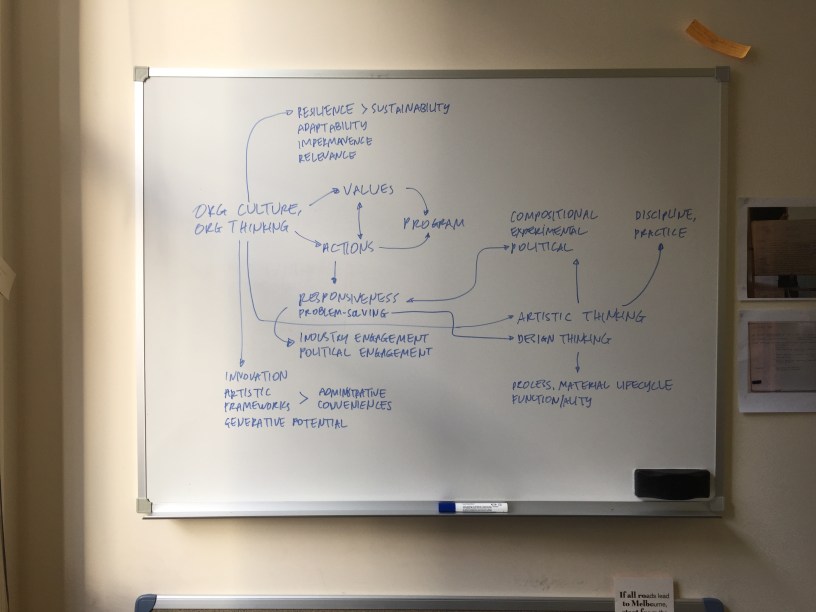Submissions to the Parliamentary Inquiry into Australia’s Creative and Cultural Industries and Institutions close on Thursday 22 October. Here’s a guide on how to start which includes a feature on the key interests and involvements of the Standing Committee on Communications and the Arts, the group of MPs leading this Inquiry.
As we continue to work through our submissions and keep encouraging others to contribute, here’s the set of recommendations I’ve drafted to date:
- To improve our understanding of the numbers of artists and creative practitioners in Australia, introduce additional questions to the Census under Income and Work and Unpaid Work to gather data on creative practice, hours worked, and creative and cultural output, capturing more than just the one professional activity
- To improve our understanding of the full scope and scale of the creative and cultural industries, conduct a Productivity Commission review or industry mapping
- To produce helpful, accurate aggregate data on cultural and creative activity, consult with industry to guide the composition of the ABS data sets that inform the Cultural & Creative Satellite Accounts, and harmonise these where possible with international approaches to facilitate global benchmarking
- Recognising the significant and growing role of local government in arts and cultural policy and investment, expand the Meeting of Cultural Ministers to include local government permanently
- Complement the expanded Meeting of Cultural Ministers with a forum that includes all ministers with cultural portfolios such as Indigenous Affairs, tourism, regional development, cities and education. One criterion that might be applied here is to consider all ministers within the portfolio scope covered by the Bureau of Communications and Arts Research $111.7bn figure. This group might take on the name of the lapsed Cultural Ministers Council.
- Empower the expanded Meeting of Cultural Ministers and the revamped Cultural Ministers Council to act on briefings on non-economic benefits at each meeting, ensuring that the value of the creative and cultural industries is well recognised and able to be applied across all relevant portfolios
- Working with the expanded Meeting of Cultural Ministers and the Cultural Ministers Council, develop a national plan that ensures all Australians benefit from the value created by our creative and cultural industries
- Remove the efficiency dividends from Australia’s National Cultural Institutions and public broadcasters
- Permanently double the Australia Council’s budget and the Regional Arts Fund
- Ensure that funding levels for the Australia Council, the Office for the Arts, their competitive grants programs, and all National Cultural Institutions, grow at a rate that exceeds CPI, ensuring that the Australian Government is a lead contributor to the growth and not the contraction of our creative and cultural industries
- Maintain clear distinctions between the role and purpose of the Office for the Arts and the Australia Council, such that all industry development and competitive grant processes (e.g. COVID-19 support) are administered through the Australia Council, while the Office for the Arts focuses on access, participation and regulatory management
- Increase the acquisitions budgets of Australia’s National Cultural Institutions and in particular Artbank, ensuring that the Australian Government takes a visionary role in enhancing our national collections, stimulating the art market and supporting artists’ livelihoods
- Restore artwork investment for self-managed super by adding an “exhibition” provision to SMSF legislation so that investment artworks can be seen, kickstarting the commercial market and propelling artists’ livelihoods
- Enhance tax incentives to motivate private giving and investment in artworks and industry development
- On industry advice, develop national standards on accessible digital presentation, apply them to all National Cultural Institutions, and open a fund through the Office for the Arts to support organisations to meet those standards
- On industry advice, ensure that best practice on artist payment and intellectual property is observed across all such digital delivery
- Substantially boost COVID-19 support to the creative and cultural industries and expand eligibility for all COVID-19 income support measures, including JobKeeper, to local government and universities, as major owners of galleries, museums, collections and art schools
- Avoid packaging industry relief packages with loan options, offering instead a Guarantee Against Loss scheme (similar to the one formerly delivered by Regional Arts Victoria on behalf of Creative Victoria), to encourage entrepreneurial response to audience demand rather than creating debt
- Permanently harmonise income averaging arrangements between the ATO and Centrelink, recognising artistic practice as professional activity, and ensuring that fees or grants received will not be treated by Centrelink as income that contributes to living expenses (thus jeopardising JobSeeker payments)
- Given its employment intensity and high jobs generation, prioritise the cultural and creative industries as the centrepiece of Australia’s COVID-19 recovery planning – crucial to strengthening the entire economy as well as restoring our local communities, our social life, and our vision for the future.
For useful facts and figures, industry specifics, and more recommendations, see:
- An excellent overview in Kate Larsen’s draft submission
- Arts Access Australia
- Australian Institute of Architects’ recent budget response
- Dr Jackie Bailey’s top eight arguments, a response by professors Justin O’Connor, Julian Meyrick and Julianne Schultz, and Arts Hub’s Director of Content George Dunford on why make a submission, all in Arts Hub
- Diversity Arts Australia
- Interactive Games and Entertainment Association’s recent budget response
- NAVA’s submission template
- A New Approach’s recent working paper with useful distinctions on the composition of key stats
- Parlour: Women, Equity, Architecture
- Regional Arts Australia’s latest advocacy and recent inquiry submissions
- Theatre Network Australia’s submission guidance
- Submissions received by the Inquiry to date.
IMAGE: A 2017 mindmap recording my thought process on what it takes for an arts organisation to work in our contemporary context.
